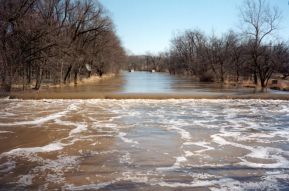Collamer, Indiana facts for kids
Quick facts for kids
Collamer, Indiana
|
|
|---|---|

Collamer Dam, over the Eel River
|
|
| Country | United States |
| State | Indiana |
| County | Whitley |
| Township | Cleveland |
| Platted | February 9, 1846 |
| Elevation | 797 ft (243 m) |
| Time zone | UTC-5 (Eastern (EST)) |
| • Summer (DST) | UTC-4 (EDT) |
| Area code(s) | 260 |
| FIPS code | 18-14320 |
| GNIS feature ID | 432761 |
Collamer is a small place in Indiana, United States. It's called an unincorporated community. This means it doesn't have its own local government like a city or town. Instead, it's part of Cleveland Township in Whitley County.
Collamer is located right on the Eel River. It's also where two roads meet: Indiana State Road 14 and Whitley County road 900 W. The town was officially planned and marked out on a map on February 9, 1846, by Smith Rambo. It was named after Jacob Collamer, who was an important government official at the time.
Contents
Where is Collamer Located?
Collamer is found at these coordinates: 41°04′33″N 85°39′53″W / 41.07583°N 85.66472°W. This helps people find its exact spot on a map.
How Many People Live Here?
Since Collamer is an unincorporated community, the government doesn't count its exact population in the same way as cities. So, we don't have recent numbers. However, in 1895, records show that about 163 people lived in Collamer.
A Look Back: Collamer's History
Early Days and Treaties
Long ago, in 1826, an important peace treaty was signed near what is now Wabash, Indiana. This treaty was between the United States government and two Native American tribes: the Potawatomi and the Miami. This agreement opened up lands north of the Wabash River for new settlers.
Before this treaty, the Potawatomi people lived in villages along the Eel River. One of their villages was near present-day North Manchester, which is southwest of Collamer. The Miami tribe, led by Chief Little Turtle, also had villages along the Eel River. These were located between South Whitley and Columbia City, northeast of Collamer.
How Collamer Got Its Name
Settlers started arriving in the Collamer area around 1845. The community was first called Millersburg. This name came from Elias Miller, who was the town's first merchant. The spot was chosen because it was close to the Wabash and Erie Railroad and the Eel River.
When the people wanted to open a post office, they found out there was already a place called Millersburg, Indiana. So, they had to pick a new name. On September 18, 1849, they chose "Collamer." They named it after Jacob Collamer, who was the Postmaster General for President Zachary Taylor. The Postmaster General was in charge of all the post offices in the country.
Growing as a Community
By 1880, Collamer had grown quite a bit. It had a "gristmill" (a mill for grinding grain), a sawmill, two general stores, and a drug store. There was also a shoe store, a school, a Christian Church, a doctor, and a post office.
In the early 1870s, a railroad line called the Detroit, Eel River & Illinois Railroad was built near Collamer. Trains started running on it in 1872. This railroad was used for many years but was eventually closed down between 1954 and 1977. Today, you can still see the Christian Church, the Collamer Church of God, and the old pillars of the railroad bridge. The post office in Collamer opened in 1849 but closed in 1922.
The Collamer Grist Mill
One important building in Collamer was its four-story Grist Mill. It was built in 1845 by Miller and Harder, even before the town was officially planned. This mill first ground corn, then wheat and other grains. The Eel River was perfect for powering the mill's large stones with water. People from long ago said the Eel River was one of the best rivers for power.
Later, around the late 1800s, the mill was updated. The old millstones were replaced with a "roller mill," which was a newer way to grind grain. For a while, between 1918 and 1934, the mill even had an electric generator. This generator helped power Collamer and a nearby community called Sidney. However, after some problems and damage from a flood, the mill stopped working. On May 19, 1934, the mill sadly collapsed.
The Collamer Dam
Collamer's most famous landmark was the Collamer Dam. The very first dam was built in 1845. It was made of wood and helped power the gristmill. In 1904, a new dam was built by O. Grant Gandy and Company. This dam stood for a long time and also helped provide power to Collamer and Sidney.
However, the dam started to have problems. It was damaged in October 2019, and there were also ongoing safety worries. Sadly, a kayaker even died there in 2017. Because of these concerns, the Collamer Dam was removed. Demolition began on January 8, 2020, and was finished the very next day.


